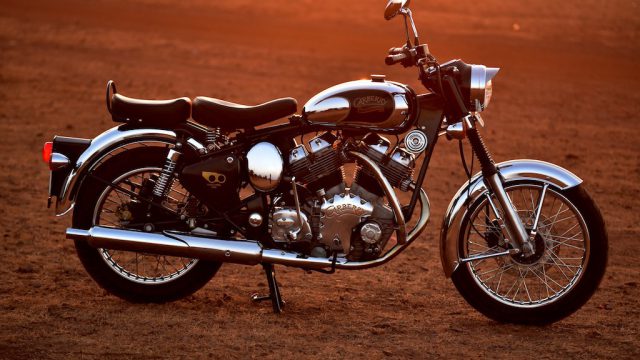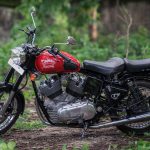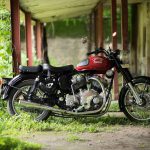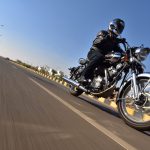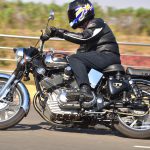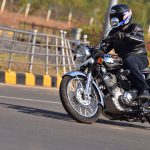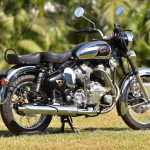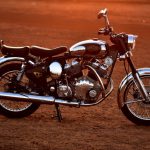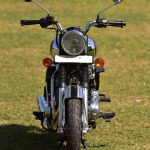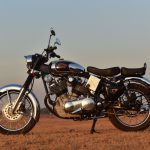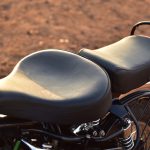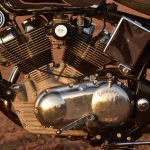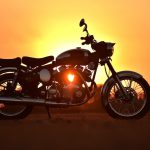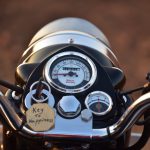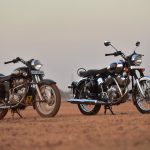Exclusive first ride on the pre-production Royal Enfield-based 998cc V-twin roadster
Last November’s global debut of Royal Enfield’s new 650cc parallel-twins at the Milan Show opened a fresh chapter in the brand’s 117-year long history, which began in Britain in 1901, but since 1955 has migrated to India. For the first time since its UK factory closed in 1970, Royal Enfield is now manufacturing twin-cylinder motorcycles as part of the Indian firm’s attempt to corner a serious slice of the middleweight 250-750cc global marketplace. Previously, its entire production – it made 825,000 bikes in 2017, 96% of them destined for buyers in its home market – were ohv pushrod singles. But now, it’s intended that its all-new single-ohc twins will propel the Indian brand to becoming a true world player. “What we’re trying to accomplish, in our own bumbling and gentle way, is world domination [of that middleweight segment]!” says Royal Enfield’s dynamic CEO Siddhartha Lal. And as well as being unduly modest, he’s not entirely joking…..
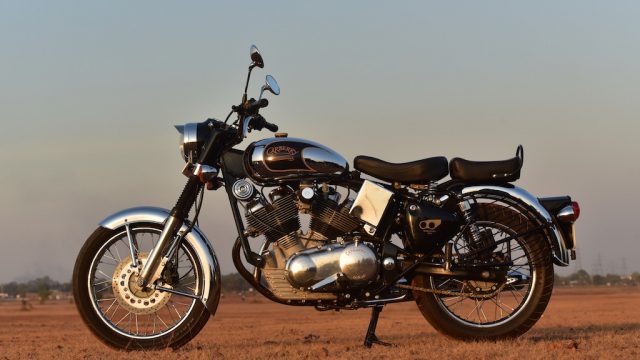
But at the other end of the scale in terms of volume and longevity is Dream Engine Manufacturers/DEM, a recently-established small-scale manufacturing operation located in Bhilai, an industrial city on the plains of Chhattisgarh state in central India, which is offering its customers a different interpretation of how an Enfield-based multi-cylinder motorcycle should be. For its Carberry Double Barrel V2 is powered by a 998cc 55º V-twin engine first conceived in Australia 15 years ago, which essentially comprises two Royal Enfield 500cc Bullet cylinders and heads on a specially designed crankcase incorporating a stock Enfield five-speed transmission, wrapped in a dedicated twin-shock classic-styled frame package. As such, it represents Plan B as an alternative way of building a twin-cylinder Royal Enfield, and it comes as no surprise that the astute Siddhartha Lal not only purchased an earlier version of the bike for his engineers at RE to assess, but has also kept close tabs on the Carberry operation, to the extent of agreeing to furnish DEM with the necessary stock Royal Enfield components to construct the Double Barrel engine and frame. Just in case, you see….
Created by Australian expat Paul Carberry, formerly Royal Enfield’s Indonesian importer, who conceived the format for this bike, and has spent 15 years pursuing its production
Billed by the local press as ‘India’s first Superbike’ on the grounds that it’s the largest capacity motorcycle yet to be entirely built in that country, the Carberry Double Barrel V2 is the brainchild of Aussie engineer Paul Carberry, who teamed up with Bhilai-based businessman Jaspreet Singh Bhatia two years ago to create DEM in order to manufacture the Double Barrel V-twin – so named in recognition of Royal Enfield’s antecedents as a shotgun manufacturer, whose rifles equipped the British Army in WW1. “We’ve named it the Double Barrel because it requires two (B)ullets, and fires two barrels!” smiles Carberry. Nice one, Paul! DEM is selling complete bikes for INR 735,000 (about £8,000 or US$11,000) tax free, or standalone motors for INR 496,000 (£5,500 or US$7,700) complete with carbs and electronic ignition. A fuel-injected Euro 4 compliant version of the engine is under development and close to customer-ready, according to Carberry, with ABS also soon to be available, both at no extra cost. “We want to offer a version of the motor with carbs for Custom bike builders,” says Paul, and as an illustration of that check out the unique award-winning Carberry-powered Chopper produced by expat Brits Paul Smith and Stuart Cantellow at Goa-based Rag & Bone Customs that’s yours for INR 1.5 million (£16,200 or US$22,750). More such creations will surely follow, given the Double Barrel motor’s meaty looks.
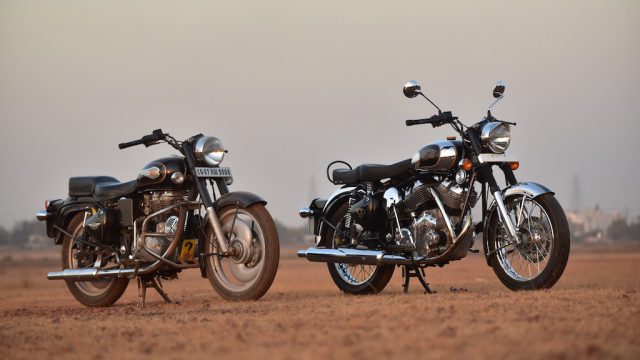
It’s hard not to admire 59-year old Paul Carberry for his persistence in completing the 15-year journey to series production readiness of his bike. His unstinting belief in the project has overcome many hurdles that might otherwise have caused a less determined individual to fall by the wayside during the roller-coaster ride that pursuing his dream of doubling up a pair of British ohv singles to produce a neo-classic pushrod V-twin has entailed. “The basic premise was to create a classic British-style 1000cc V-Twin using as many stock Royal Enfield parts as possible,” says Paul. “The Bullet single’s a lovely little bike – but it is a little one, so it’s just a bit lean on power. That’s the only thing against it nowadays, when everyone’s going retro and neo-classics are selling so well. So adding an extra cylinder takes care of that, as well as making the kind of bike I personally like, and which I know other people do, too. My aim is to offer a well-mannered torquey cruiser with the look, the feel and the sound you’d expect from a bike with a traditional British character, that’s fun to ride, but has enough modern technology to make it reliable, all at an affordable price.” And that last objective meant building it in India, for his design parameters for the Double Barrel engine also focused on keeping production and maintenance costs down to a minimum, via the worldwide availability of Enfield parts.
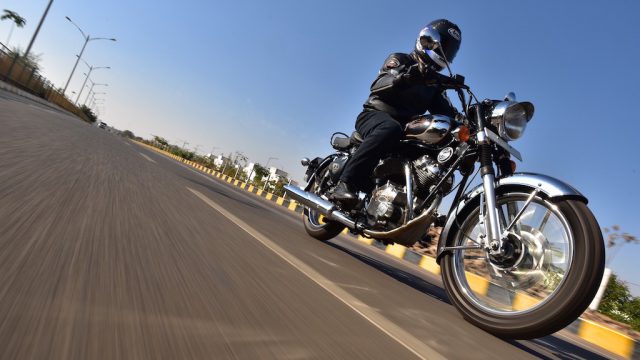
However, Paul Carberry first conceived the Double Barrel during a seven-year spell in Jakarta, Indonesia, mostly spent profitably hoovering up WLA Harley V-twins left over from WW2, and restoring them to sell in the USA and Oz. Along the way he began importing Royal Enfields for sale in Indonesia, after visiting the firm’s Chennai HQ. That’s when he had his ‘what-if’ moment, and started down the path of making his own multi-cylinder Enfield-based motorcycle. But to create the Carberry-Enfield V2 motor, Paul headed back Down Under to call on the services of Melbourne-based development engineer Ian Drysdale, creator of the Drysdale V8 sportbikes, and a man with a formidable track record of thinking outside the box. It’s a big leap from manufacturing a street-legal four-camshaft 32-valve V8 sportbike for customer sale, to concocting a dedicated pushrod V-twin engine for a retro roadster, but when your name is Ian Drysdale, engineering variety is the spice of life. “It was an enticing challenge to produce something low-tech on two wheels, for a change,” says Ian, a 21st century maverick engineer of eclectic vision, who asks not why, only how.
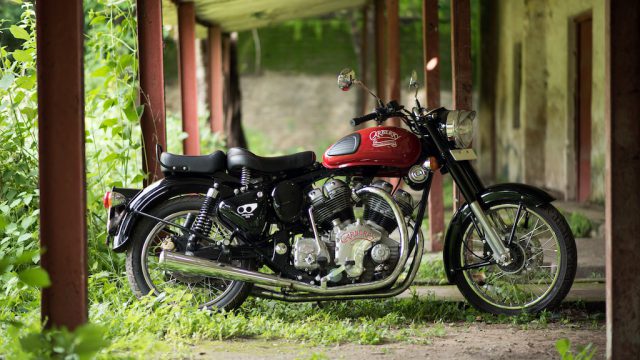
Drysdale’s 2003 prototype air-cooled ohv 998cc 55º V-twin engine measuring 84 x 90mm covered thousands of kilometres of road testing in Paul Carberry’s hands, fitted in a twin-shock frame he’d designed and made himself. This used a braced section of the Enfield Bullet chassis at the rear, mated to a specially-fabricated front section with twin downtubes and a double frame backbone. The dry-sump engine’s ideal 60% balance factor was achieved by heavy-metal weights plugged into the crank flywheels, delivering a level of smoothness with the relatively tight cylinder angle which you’d normally only achieve via a power-sapping counterbalancer.
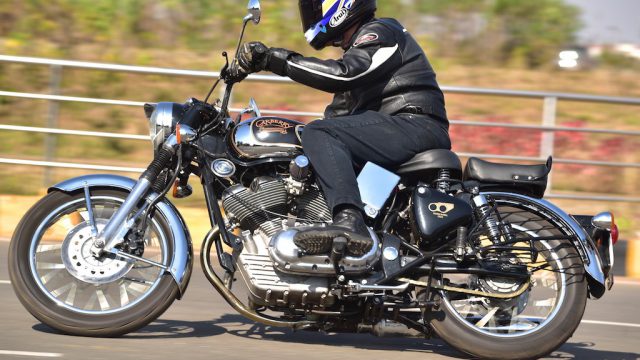
But the path to production was not an easy one, and constant refinement not only consumed money, but also time that could have been spent earning the income needed to survive. “The idea was to make money out of doing something I love, but it’s sometimes been a love-hate relationship!” says Paul. “I put everything into the V-twin project, to the point that I lost my house and was made personally bankrupt. But eventually I teamed up with a couple of partners to put the fully-homologated ADR-compliant bike into production at a factory up in the mountains outside Melbourne. By now it had grown to 1100cc and had Enfield’s new five-speed gearbox, and it was a pretty good bike – all our customers were certainly pleased with it. But we only managed a short production run of just 13 complete motorcycles and a couple of engines before the rising cost of raw materials and overheads meant it all had to be shut down. But then after a few years doing other things, I began getting calls from people from all over the world, including India and China, about getting the project going again. Jaspreet was one of them, but the difference was that he actually did something about it, rather than just talk! We worked out an agreement, and I moved over here early in 2016 together with my lovely wife Luka, who’s been incredibly supportive all the way through. Jaspreet set us up with somewhere to live, and a factory to build the bikes in, as well as a staff of up to 14 people at any one time, all of them locals who are eager to see the company succeed. I started hunting around for vendors and machinists and so on, which was a difficult task locally because there’s no automotive industry suppliers here in Chhattisgarh. But we eventually sourced the needed components from all over India, and now it’s all finally come together, so that we’re ready to start satisfying orders.”
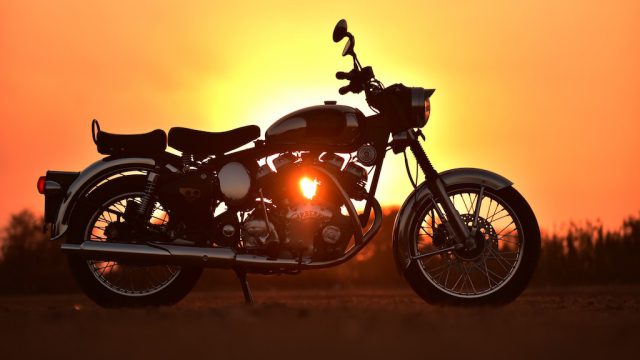
Bike-loving entrepreneur Jaspreet Singh Bhatia, 33, is from a Sikh family with various business interests ranging from paper and cardboard manufacture to liquor stores, and investments in property and precious stones. In a country where a Royal Enfield 500 Bullet is considered to be a superbike, Jaspreet’s ownership of a Kawasaki ZRX1200 alongside various vintage bikes like a BSA B31 and a Honda CL350, all of which he says he rides regularly, stamp him as an avid biker with a passion for two-wheeled engineering. “I used to trade in bikes and cars as a hobby, especially Harley-Davidsons, which I used to restore myself, and then sell,” he says. “Originally, I wanted a Carberry engine to build a Custom bike around it, which appealed to me because it used Royal Enfield parts. So in 2015 I contacted Paul, who told me that he’s not producing engines any more – he had all the moulds and drawings, but was lacking in funds. So I asked him if he wanted to leave it all on the shelf, or did he want to restart the project and make some money out of it? He came to India, we had a talk, and decided to set up this business together. He had the trust in me, I have the trust in his technology, and together we’ve built an excellent machine which I’m looking forward to putting into series production. I wanted to buy an engine, but instead I ended up buying a company!”
Conceived to employ as many Royal Enfield components as practicable to give worldwide spare parts backup via Enfield distributors
The original 2003 Drysdale-built Carberry-Enfield motor utilised the cast iron cylinders and four-speed gearbox of the then-current vintage-era Bullet single. But in 2007 Royal Enfield introduced the current much improved all-aluminium unit-construction UCE engine with a five-speed transmission, and it’s this which forms the basis of today’s 998cc Double Barrel V2 dry-sump pushrod motor weighing 90kg together with the 32mm Keihin carbs currently fitted, or throttle bodies for the forthcoming EFI version. The all-new crankcases carry a pair of 500 Bullet cylinders surmounted by stock Royal Enfield cylinder head assemblies, complete with original valves and springs. Also from the stock Bullet parts bin are the steel conrods and cast pistons delivering the same 8.5:1 compression ratio, mounted on a special roller-bearing crankshaft. This is supported by dual main bearings on each side, which Carberry says helps achieve smoothness as well as crank rigidity, with ball bearings on the left-hand side and double heavy-duty rollers on the right. The high-pressure high-flow oil system features twin modified automotive-sourced pumps, and a spin-on filter. Internal oil lines see the feed to the stock rockers slightly constricted to raise the oil pressure for better lubrication, says Carberry, who’s also fitted new pushrods matched to specially-made plain-bearing rockers and hydraulic lifters, which are accommodated above the standard Royal Enfield cams without modification to the cylinders.
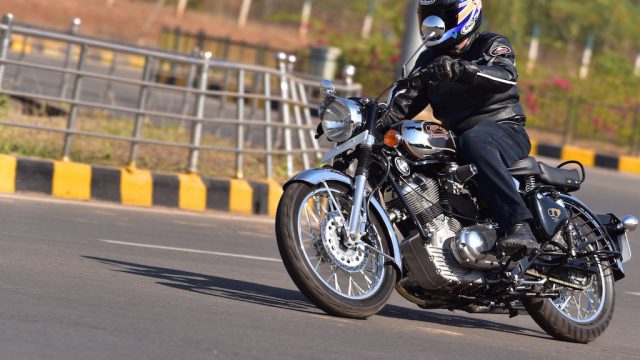
Behind the left-side primary cover lies a duplex chain primary drive to the separate five-speed Royal Enfield gearbox, matched to a beefed-up Enfield oil-bath clutch, while gearing has been raised by a massive four teeth on the engine sprocket (25T to 29T, so about 12T at the back wheel!) versus a 500 Bullet, to take account of the V-twin’s extra performance over the ohv single. “We use the same UCE camshaft as the Bullet,” says Carberry, “but this behaves a little differently than in the stock Enfield, because it was designed to run with roller rockers there, and with our flat bottom plain-bearing rockers it has a steeper drive, and a longer duration.” Indeed, there’s potentially quite a bit of extra power available by playing with cam profiles and timing, plus the Carberry engine is apparently capable of being taken out to 1300cc quite safely, which would produce extra zest from a sports version, if needed. But the present 52.4 bhp at 4,800 rpm delivered to the rear wheel in current carburetted form (56 bhp is expected from the fuel-injected version) is quite sufficient to meet the expectations of Dream Engine’s target customers, and the 82.6 Nm/61 ft-lb of peak torque delivered at just 4,000 rpm ensures a meaty but relaxed engine response that’s entirely in keeping with the Carberry V2’s period-style twin-shock cycle parts, and retro cruiser character.
Modern-day retro roadster with period charm, but modern functionality
Carberry has fitted a heavy-duty Mitsubishi starter motor as used on a Ford Courier van to the Double Barrel engine, so it cranks immediately into life before settling to a smooth, rather muted but definitely sonorous offbeat idle – the 2-1 exhaust uses a silencer from the Bullet single, and that keeps noise levels down. The riding position is very rational, with the 800mm-tall rider’s section of the two-part seat plush and comfortable. However, the battery box digs in to your upper left thigh, which is not only painful but also means that even a 1.80m/5’10” tall rider must tiptoe at traffic lights, rather than plant his – or her – left foot flat on the ground. While complaining, the Bullet-sourced sidestand is much too short, and this means you must be very careful where you park up the Carberry. However, when you do stop to admire it, it’s hard not to applaud the real sense of presence that the bike undoubtedly has – the Royal Enfield ohv cylinders look quite meaty, in spite of being completely standard. In terms of looks this has all the hallmarks of a true modern classic.

But one with modern performance? Yes, pretty much adequately so, for Paul Carberry has made his Double Barrel shotgun of a motorcycle into a straight-shooting, pleasurable ride down memory lane, but in a modern context, as a ride out into the traffic-free countryside around Bhilai amply confirmed, aboard the pre-production Double Barrel V2 still fitted with carburettors and deprived of ABS. The performance of the Carberry’s V2 motor is zestful and pleasing, though the thing that strikes you most is how smooth it is – there’s none of the tiring tingles at real world speeds of other narrow-angle pushrod V-twins sharing the same simple-is-best retro charm. It’s very well-balanced, with only a little noticeable vibration through the footrests when the speedo needle reaches 110 kmh in top gear, but none through the seat or handlebar.
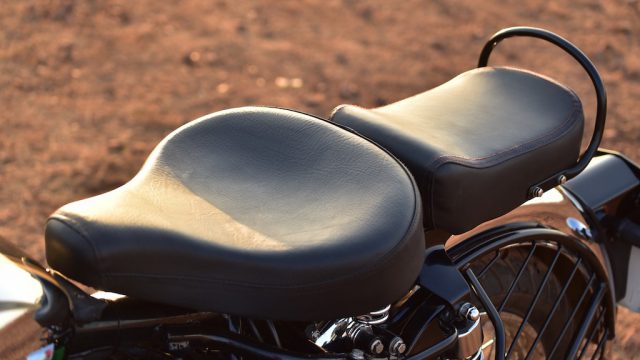
The result is a 55º V-twin that’s as relaxing and smooth to ride as a 90º one, achieved without the use of a balance shaft, just through clever engineering. There’s just the same flexible, forgivingly torquey punch as on any Ducati desmodue, with the Carberry V2 happy to pull away wide open in top gear from as low as 40 kmh on the Enfield speedo, without a hint of transmission snatch – nor, it must be said, a great deal of haste. You’ll keep up with traffic quite easily, but 54 bhp from a bike weighing 230kg with oil but no fuel isn’t a recipe for remotely sporty performance, just easy-going easy-riding with quite acceptable pickup out of turns from a closed or partial throttle, and good top-gear roll-on from 80 kmh onwards. Carberry says he’s refined the carburation and valve timing to improve response and pickup from down low, and it’s a job well done – although the most recent of my two previous rides a decade ago on his Australian-built prototype showed he was already working in the right direction.
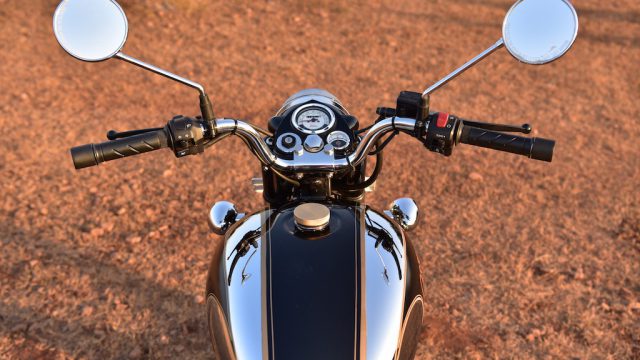
For this is now a sweet and surprisingly sophisticated-seeming power unit that’s quiet and refined in operation, at odds with its frankly humble retro antecedents. It gallops along well in top gear at an indicated 120 kmh, when I’d guess in the absence of a tacho that the motor would be turning at around 4,000 rpm. So it’s quite long-legged, and certainly more practical to ride in real-world Western conditions than a Royal Enfield single, mainly because it doesn’t run out of breath at 100 kmh, like a 500 Bullet does. You don’t need to use the light-action clutch to change up a gear on the smooth and precise shifting five-speed transmission, even though this has been beefed up from stock for the Carberry’s extra torque, and in spite of being designed for a single, its ratios are well adapted to a torquier and more powerful V-twin application. The bottom two gears are quite low to get the show on the road, especially with a passenger, with the top three ratios more evenly spaced. I held fourth gear to 120 kmh on the speedo, then nicked fifth very smoothly, with more top end performance seemingly to come, although I think Paul Carberry’s estimated top speed of 115 mph/180 km/h might be a little over-optimistic. Anyway, it’s not that kind of bike – cruising along at 130 kmh looking out for stray animals and especially cows which have the absolute right of way anywhere in India, and not just for reasons of size and weight, was both relaxing and enjoyable.
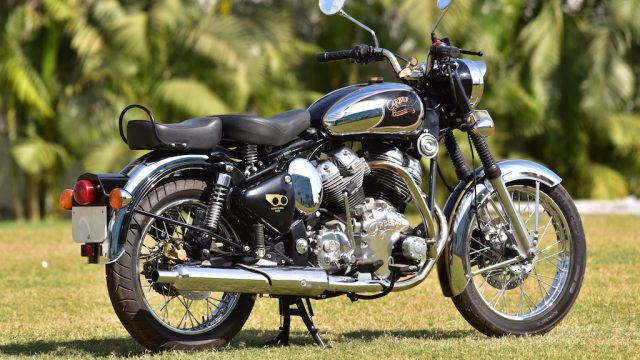
The Double Barrel’s Indian-built frame is a new open-cradle design by Paul Carberry made from cold drawn steel tube, with a 50mm-diameter tubular steel backbone and twin front downtubes, which uses the engine as a fully stressed frame member, with a Bullet rear loop, which supports the seat. The swingarm pivot area has also been beefed up compared to before. There’s acceptably good ride quality in spite of the twin-shock rear end, which delivers just 80mm of wheel travel. But though via the Indian-made gas shocks sourced from a 500 Bullet are quite softly-sprung they’re still acceptably well damped, so that the Carberry doesn’t wallow or weave even when you hit a bump in the road surface leaned over a little. Up front, the 35mm RE leading-axle telescopic fork gives 130mm of wheel travel and is also softly damped, except that there isn’t remotely that fierce a bite from the single 280mm steel disc gripped by an Indian-made Pricol twin-piston caliper, to make the front end dive excessively under hard braking.
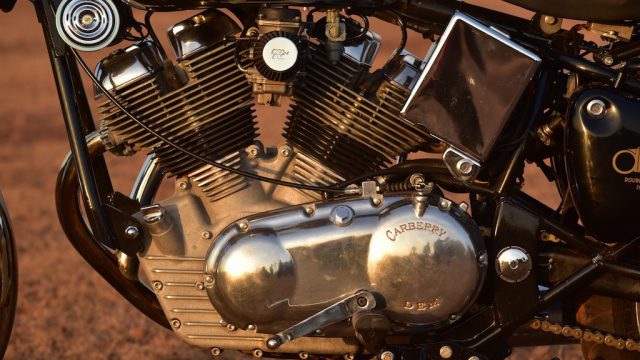
The Carberry V2 handles pretty well, with its wire wheels’ steel rims shod with Pirelli Sport Demons, and a rear 18-incher replacing the stock 19-inch Enfield rim which is retained up front, to make sure there’s sufficient ground clearance for reasonably spirited cornering. This has the effect of lowering the bike slightly at the rear, and kicking out the stock Enfield fork (which has been revalved and fitted with stiffer springs) even more than the wide 27.5º head angle Paul Carberry opted for, with 98mm of trail. Coupled with the rangy 1520mm wheelbase, the result is a bike that’s very stable, yet was surprisingly easy to change direction on in a fast S-bend – not nimble, exactly, but definitely less ponderous in its steering that the previous Carberry-Enfield 1100 was with a different frame. So there’s no need to tug unduly hard on the ‘bars to flick the Carberry from side to side. Stopping is another matter, without as much bite as I’d have preferred from that 280mm front disc whose twin-pot caliper was rather wooden in its response. Could be it needs different pads, since fortunately the smaller 240mm rear disc proved surprisingly effective. You must use them both quite hard to stop from any speed. Bosch ABS sourced from Royal Enfield will be fitted to all customer bikes built from now on, assures Carberry. “I’d like to thank Siddhartha Lal for all his support on many different levels, from supplying us with parts to manufacture the bike up to even a little bit of help on the homologation,” he says. “Royal Enfield has just been really good to us, and we’re so grateful for that.”
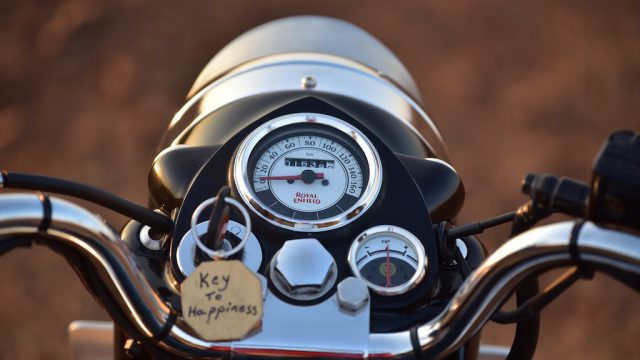
The Carberry Double Barrel V2 is an enticing ride down memory lane in a modern context, which deserves to reach a wider public now that Paul Carberry has sourced the investment to put it into production at last, and thus to offer a unique hand-built modern classic to the growing global market for such a bike. It’s well priced and seemingly well engineered, but for the global sales that Carberry and Jaspreet Singh Bhatia are now geared up to meet, alongside ABS they do need to get the fuel injected version of the bike ready for production as soon as possible. Without that there’s no hope of achieving the Euro 4 compliance that’ll be necessary to sell the Double Barrel V2 in the USA and Europe, including – even post-Brexit – its biggest potential market, in the UK. But the hardest part of Paul Carberry’s 15-year journey is over, and the end result of that is an Indian-built bike quite unlike anything else available in today’s marketplace – and especially not at the same price. On that basis, his target of selling around 200 bikes a year annual units by 2020 does look achievable.
You can also read: 2018 Triumph Speed Triple price announced
